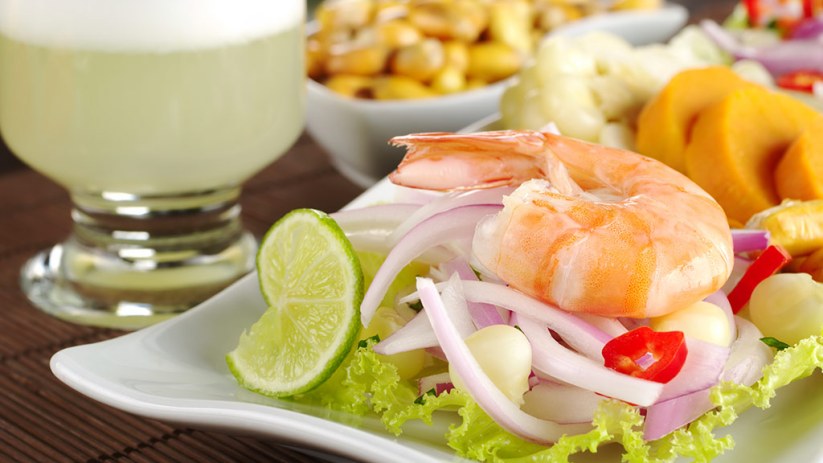At the World Travel Awards, Peru has been chosen as the leading culinary destination in the world for five consecutive years. A magnificent feat when you consider that it was just a little over 10 years ago that the Peruvian food movement gained momentum in the same Andean country. With the gastronomic boom, the reinvention of how Peru dishes are prepared is due to a group of chefs with a vision of the future Gaston Acurio, and Pedro Miguel Schiaffino among others, they have brought Peruvian cuisine to the world stage with a mix of different foreign cooking techniques applied over Peruvian ingredients to what we see in the best restaurants in Peru today. For this reason, together with our colleagues from Machu Travel Peru, we have prepared a small article about the best traditional Peru dishes. Learn a little more about these ancestral delicacies!
30 best dishes of Peru gastronomy
- Ceviche (Peruvian sushi)
- Leche de Tigre (Tiger’s Milk)
- Jalea (Seafood Fried Chunks)
- Tiradito (Marined raw fish)
- Sudado de Pescado (Steamed Fish)
- Cau Cau (Cattle tripe stew)
- Arroz con Pato (Rice with duck)
- Tacu Tacu (Fried rice and bean dough)
- Ají de Gallina (Creamy Chicken)
- Causa Rellena (Potato Casserole)
- Arroz con Pollo (Rice with Chicken)
- Carapulcra (Spicy chicken and minced pork dressing)
- Seco de Res (Cilantro Beef Stew)
- Lomo Saltado (Stir-Fried Beef)
- Arroz Chaufa (Chaufa Rice)
- Pollo a la Brasa (Roasted Chicken)
- Anticuchos (Grilled Heart)
- Trucha Frita (Fried trout)
- Chicharron (Fried Pork Rind)
- Pachamanca (Steamed food underground)
- Papa a la Huancaina (Potatoes in Spicy Cheese Sauce)
- Juane (Rice with chicken wrapped in banana leaves)
- Tacacho (Baked banana dough)
- Cuy Chactado (Guinea Pig)
- Rocoto Relleno (Stuffed Spicy Peppers)
- Adobo (Spicy pork stew)
- Chupe de Camarones (Shrimp Chowder)
- Capchi de Setas (Muoshrom stew)
- Chiriuchu (Dried meat chunks)
- Guiso de Tarwi (Tarwi Stew)
1. Ceviche (Peruvian Sushi)
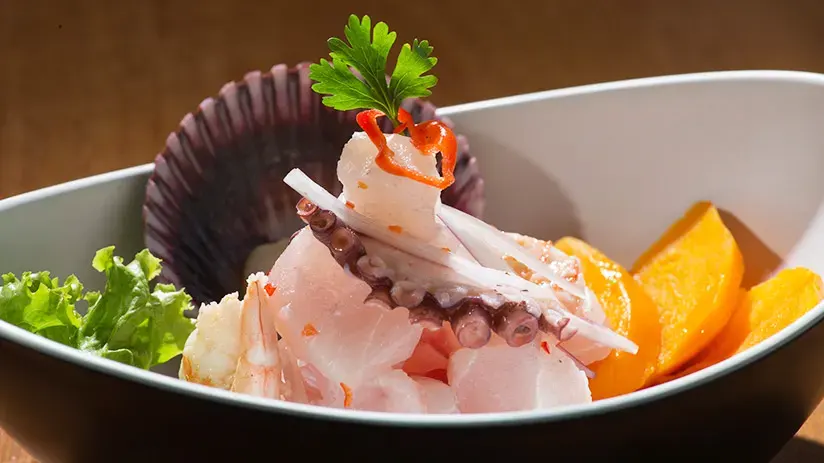
If you are on the coast of Peru, you must try the renowned and popular Peruvian ceviche. It is maybe the Peru food that has made the country known throughout the world. Despite many countries in the region having their own ceviche dish, there is not something similar in taste and quality to Peruvian ceviche. Also according to some historical sources, ceviche originated about 2,000 years ago with the Moches, a pre-Inca culture on the coasts of Peru.
The rest of South America prepares Peruvian Ceviche in different forms. The fish is marinated in lemon juice, chopped hot pepper, and salt (by 5 – 10 minutes) and then served immediately with lettuce salad with fresh onion slices, toasted (breaded and/or toasted corn kernels), and Cochayuyo (red algae that grow in cold water shores along the Peruvian coast). It is served cold. Although, due to its great influence throughout the country, there are numerous presentations with unique ingredients.
Where to eat Ceviche?
La Mar Cevicheria. Address: 770 La Mar Avenue, Miraflores, Lima.
2. Leche De Tigre (Tiger’s Milk)
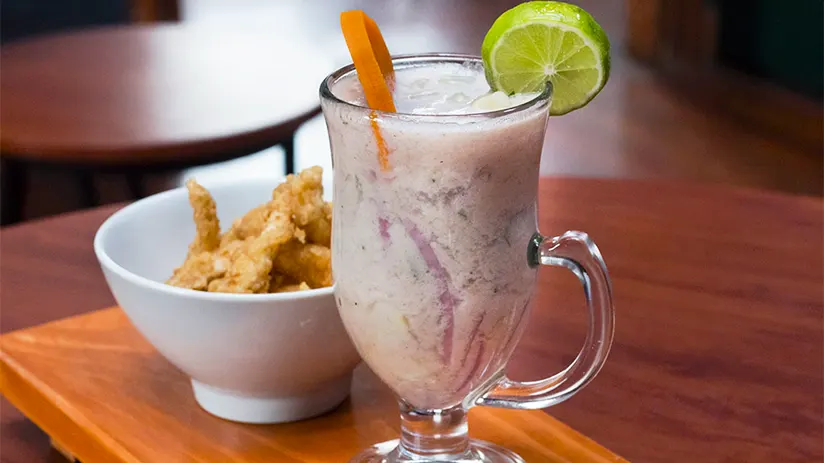
Leche de Tigre (Tiger milk) is white, although it does not necessarily contain milk in its preparation. Therefore, Leche de Tigre is often confused with the delicious leftover juice from Peruvian Ceviche. But this is not entirely accurate. The Peruvian cooks prepare Leche de Tigre separately from ceviche. A very delicious fish broth is its principal ingredient. This one has lemon juice, salt, pepper, and a few spices. Different chefs add baked corn kernels, fish, and shrimp to a cocktail glass. All in an attempt to complement the delicious marinade and thus give rise to the Leche de Tigre.
Many Peruvians believe that Leche de Tigre is an aperitif that will restore your energy. Many even believe that it is an aphrodisiac.
Where to eat Leche De Tigre?
La Preferida. Address: La Encalada Avenue 908 Urb. Monterrico, Surco.
3. Jalea (Seafood Fried Chunks)
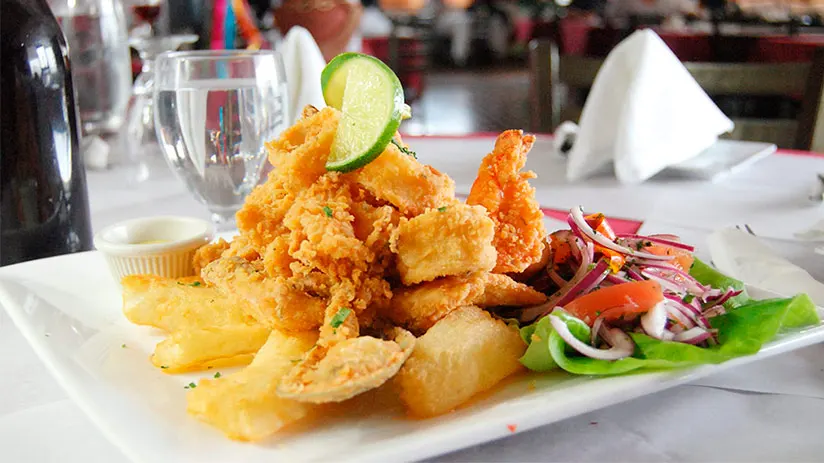
Many scholars affirm that the Jalea could be the equivalent of fried chips and fish. It is one of the seafood dishes most chosen by the inhabitants of Peru. We recommend you try Jalea Mixta, a variety of breaded and fried fish and shellfish. Note that instead of fries, the Jalea plate includes fried Yucca. But this one is no less delicious than the Peruvian potatoes.
The jelly is generally accompanied by Salsa Criolla (Creole Sauce) or Salsa De Ají (Spicy Sauce). The spicy and citrus flavor goes great with fried fish.
Where to eat Jalea?
Punto Azul Cevicheria. Address: Benavides Avenue 2370 – Miraflores, Lima.
4. Tiradito (Marined raw fish)
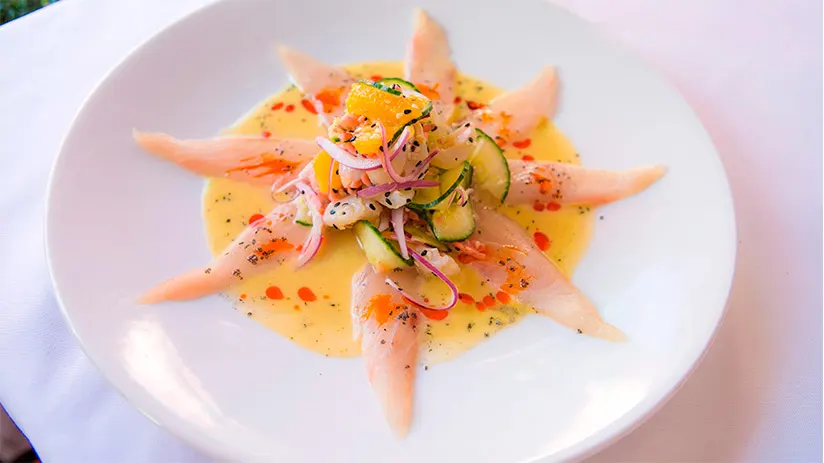
Nikkei cuisine combines two of the best cuisines in the world, the Japanese and Peruvian cuisines. And, among the most characteristic dishes of this culinary trend is the fish Tiradito. This is the other name by which he is known. Usually, this Peruvian seafood dish has raw fish cut into very thin strips, like Japanese Sashimi. It is accompanied by a spicy and citrus sauce that enhances the flavor of the fish. Lime, yellow pepper (aji amarillo), garlic, and coriander, resulting in a light, simple, and delicious sauce that forms this dish.
Where to eat Tiradito?
Maido Restaurant. Address: San Martin Street 399. Corner with Colon Street, Miraflores – Lima.
5. Sudado de Pescado (Steamed Fish)
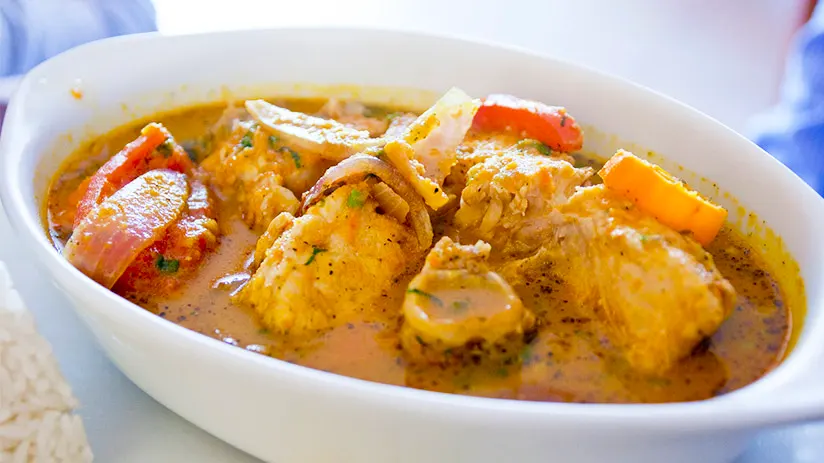
Peruvian cuisine has a variety of soups that recovered importance with the entrance of Japanese people and their influence on gastronomy. Sudado de Pescado is one of them. The Nikkei Gastronomy (Peruvian-Japanese gastronomy mix) revalued this traditional Peruvian soup around 1980 and, as its name indicated, the fish sweats when steamed. Inside a pressure cooker, the fish sweat accompanied by yellow pepper, tomato, garlic, cilantro, and onion dressing. In Peru’s north, the dressing usually includes the famous Chica de Jora. On the other hand, Wine or Pisco replaces the Chicha on the south Peruvian coast. This traditional food is typically accompanied by cooked yucca. In zones like Chiclayo, Grouper, Grape Eye, or Tollo is the perfect type of fish to prepare it. In Lima, the capital of Peru, the Lorna, Cojinova, Chita, or Corvina is the starfish of this dish. Dare to taste it!
Where to eat Sudado de Pescado?
Pescados Capitales Restaurant. Address: Mariscal La Mar Avenue 1337, Miraflores, Lima.
6. Cau Cau (Cattle tripe stew)
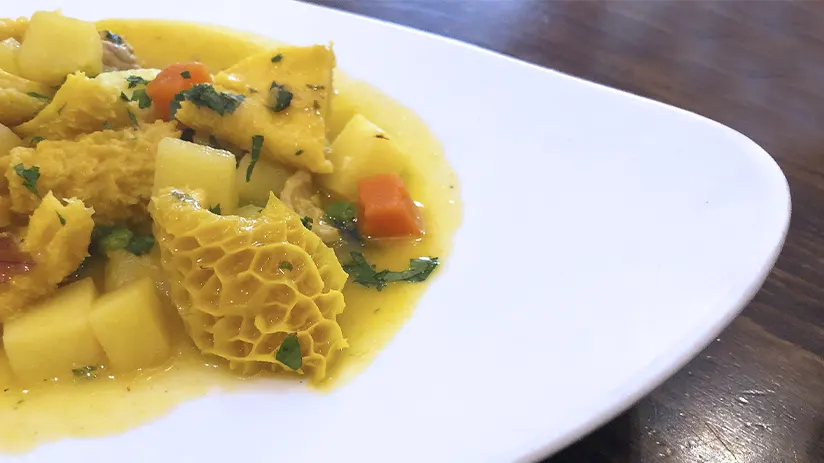
The origin of its particular name has many theories. Some affirm that it comes from the Quechua language Acacau and means giblets and hot. Others indicate that Chinese immigrants, in the nineteenth century, used the Caucau phoneme to indicate that the ingredients of stew had to be chopped into very small portions. Others say that the name comes from another Quechua name Kau-Kau. And, it refers to another ancient dish with fish eggs and seaweed (Cochayuyo), two ingredients that belonged to the original recipe and were lost in time. Be that as it may, the truth is that the dish comes from the hands of African slaves who came to Peru to work on the wine and cotton plantations.
The dish consists of cow tripe or chicken and white Peruvian potatoes. All of them were chopped into small cubes and cooked over a base stew of garlic, drumstick, onion, yellow pepper, chopped parsley, and mint. The preparation is accompanied by rice, as the majority of Peruvian dishes.
Where to eat Cau Cau?
Antigua Taberna Queirolo. Address: San Martin Avenue 1090, Pueblo Libre, Lima.
7. Arroz con Pato (Rice with duck)
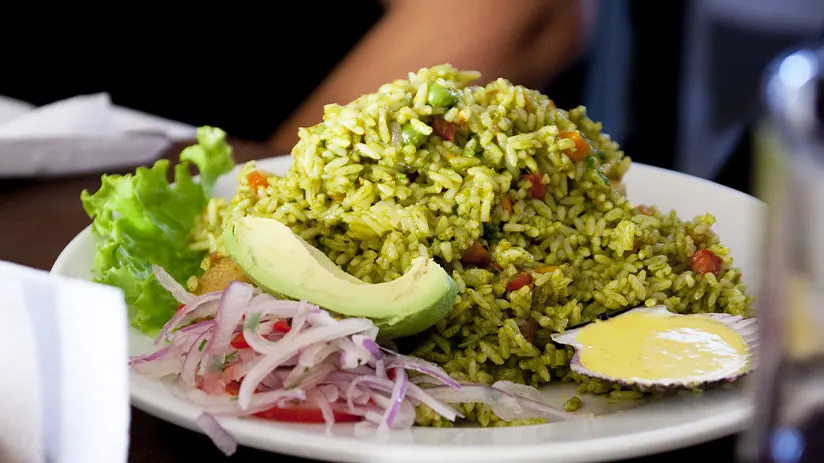
Arroz con Pato or Rice with Duckis a Creole recipe with great Spanish influences. This star dish in Peru is a classic among its locals. In addition, the chefs cook the rice with herbs, coriander paste, and dark beer. This way of preparation gives a pronounced earthy flavor to the rice. Then, the cooks add a roasted duck thigh or leg, which has a truly crunchy texture over the rice bed. A true delight.
Where to eat Arroz con Pato?
Fiesta restaurant. Address: Reducto 1278 Avenue. Miraflores, Lima.
8. Tacu Tacu (Fried rice and bean dough)
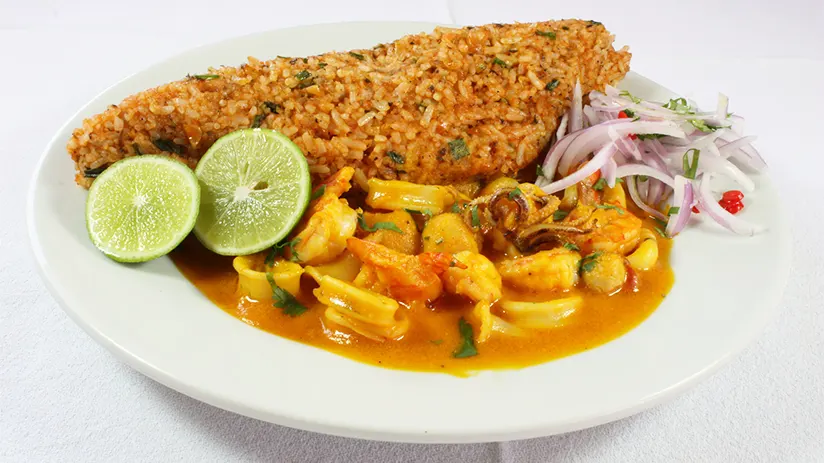
Tacu Tacu is one of the dishes that usually contain rice and beans. It is a Creole food with a bit of Spanish, African, and South American influences. It is a dish of flavor and pronounced textures that are perfect to satisfy the appetite on a long day. Bean stew and white rice usually made the Tacu Tacu, both mixed and fried in a deep frying pan for some minutes. The dish is served, still hot, and is accompanied by beef steak or fried egg. Although, its preparation may vary from one place to another. It is very easy to cook and has a wide variety of unique flavors. It is a very pleasant Peruvian dish for those who try it for the first time.
Where to eat Tacu Tacu?
Tato restaurant. Address: Chorrillos Avenue 383, Barranca, Lima.
9. Ají de Gallina (Creamy chicken)
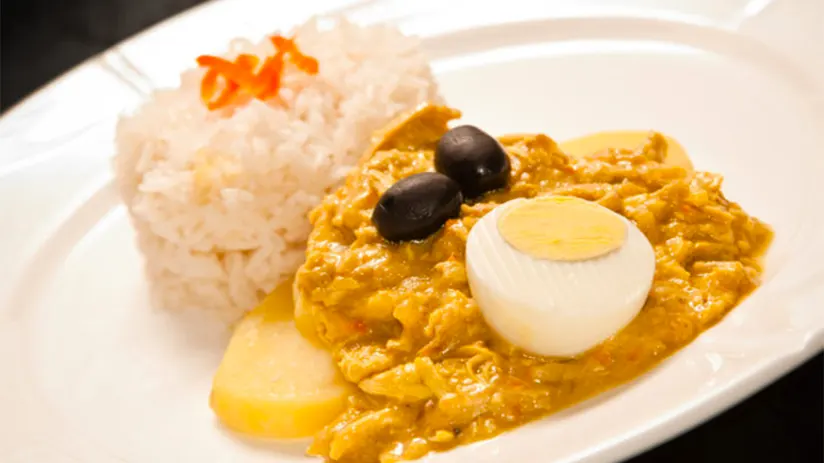
Another of the traditional dishes that you cannot miss. Aji de Gallina is a dish of a delicious mixture of shredded chicken, bread, milk cream, olives, yellow pepper, and finely chopped onions cooked for 45 minutes approx. The resulting creamy past is served over potato slices (boiled separately) and accompanied by white rice and soft-boiled egg slices. There are many theories on how this unique dish came about. The sure thing is the women Peruvian slave created the dish, having as the base, discarded chicken rest from Spanish tables. However, nowadays, it is one of the most wonderful flavors of Peru and you really should try it.
Where to eat Aji de Gallina?
Tanta restaurant. Address: Pancho Fierro Street 115, San Isidro, Lima.
10. Causa Rellena (Potato casserole)
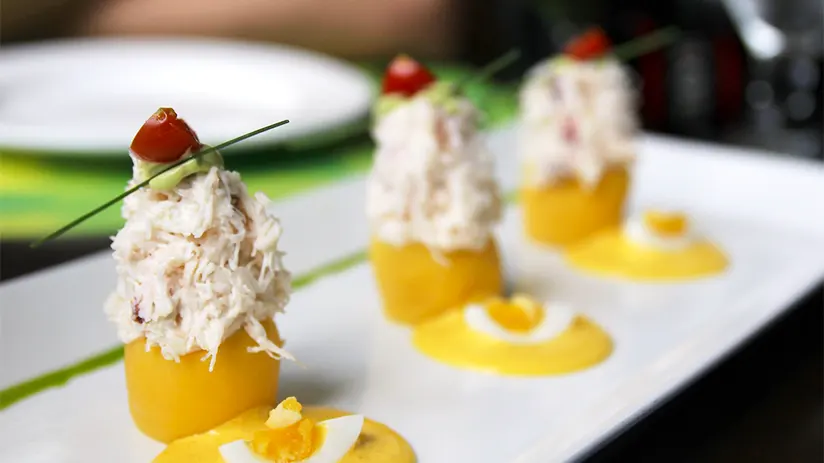
The famous Causa Rellena is very popular in Peruvian cuisine. Peru has many varieties of potatoes, so you might expect many potato-based dishes. Mashed potatoes, seasoned with lemon juice and salt participate in its preparation. The mashed goes, in the form of thick sheets, between thick fillings with ingredients such as mayonnaise, tuna, avocado, celery, olives, or chicken. Most of the time, it serves as an appetizer, and many sauces, especially hot ones accompany the dish.
Its name origin has many theories. One of them refers to that Causa comes from the Quechua word Kausay and means “necessary sustenance” or “food”. Others indicate that Peruvian women, as a form of collaboration to the Cause of Peru’s independence, prepared this dish for the independence troops of General San Martin. The last theory indicates that, again, the Peruvian women, fed to Peruvian soldiers, in the middle of the Pacific battle against Chile, with this dish, to stand by the Peruvian Cause.
Where to eat Causa Rellena?
El Bodegón restaurant. Address: Tarapaca Avenue 197, Miraflores, Lima.
11. Arroz con Pollo (Rice with chicken)
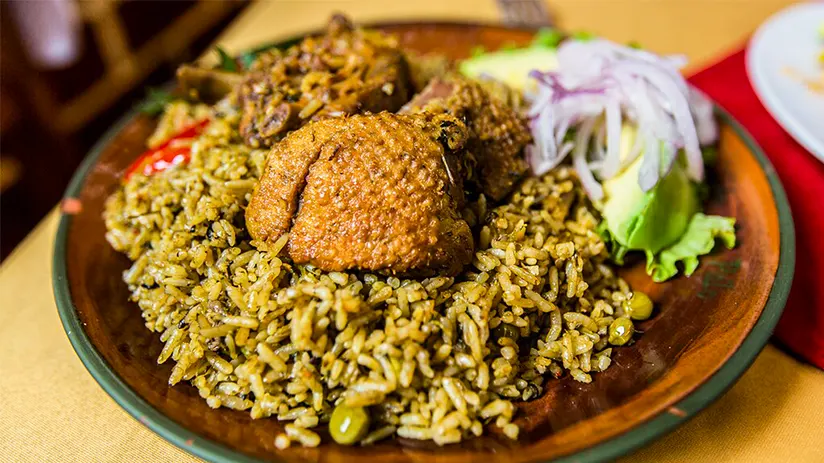
This is an important dish that forms the Peruvian daily diet, and its preparation is a tribute to the variety of spices that Peru has. Maybe, with Ceviche, the Arroz con Pollo can be the most representative Peruvian food. On an additional note, the Arroz con Pollo shares the style of preparation with Spanish Paella but uses local and tasty ingredients. The rice chicken dams are cooked with diced carrot, bell pepper, capers, celery, shelled corn, green beans, onion, shelled corn, olives, and peas. All of them are mixed over a rice bed (Previously, the rice had to be seasoned with coriander, garlic, thyme, and bay leaf). The preparation is cooked for 30 minutes and, it is done!
Where to eat Arroz con Pollo?
Tanta restaurant. Address: Pancho Fierro Street 115, San Isidro, Lima.
12. Carapulcra (Spicy chicken and minced pork dressing)
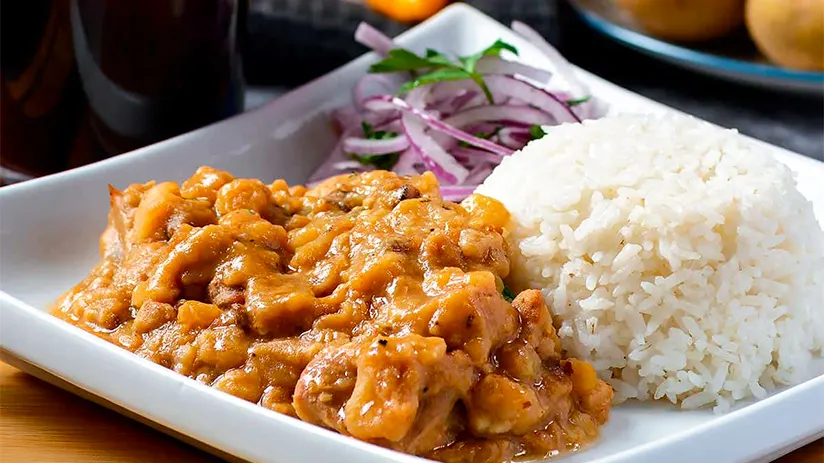
Carapulcra is a Peruvian dish that intertwined the Aymaras people of the Altiplano mountains with the African culture located on the Peruvian coast south. These people cooked the Carapulcra since ancient times. Even, they named this Peruvian dish Qala Purka (In the Aymara language, means “stew made on hot stones”). The preparation consisted of a thick Alpaca meat soup with dried potatoes and little stones preheated, all of them cooked inside a saucepan. Carapulcra was the perfect dish to face the aggressive Altiplano weather, cold, dry, and extreme frost.
In colonial times, the dish crossed the Peruvian territory from east to west, until the south coast of Lima, specifically to the Chincha region. This zone hosted the majority of slaves coming from Africa (They worked in the wine and cotton fields located around). They included, to the preparation, extra ingredients that contributed flavor, spice, and color to the dish. Even, the local Spanish language adopted the word Carapulcra (Cara = dear / Pulchra = beauty). The preparation was very similar to the Aymara dish, with the difference of the addition of the chicken and pork pieces in a dressing of yellow peppers, clove, onion, garlic, salt, and pepper. A giant saucepan with some preheated stones kept this mix, by cooking them.
Where to eat Carapulcra?
El rincón Que No Conoces (The Corner Don’t You Know) Restaurant. Address: José Bernardo Alcedo Street 363, Lince, Lima.
13. Seco de Carne (Cilantro Beef Stew)
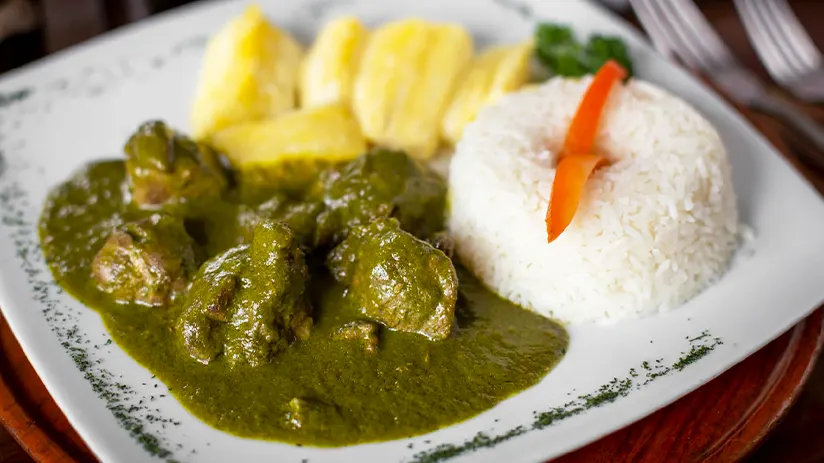
One of the traditional dishes of Peru’s north is the most chosen among the locals. The Seco de Carne or Seco de Res is a hearty beef stew. However, several ingredients set it apart from other meat stews. This recipe uses cumin, peppercorn, yellow peppers, the well-known Chicha de Jora (one of the most traditional Peruvian drinks), and coriander, two key ingredients in this dish. A pressure cooker, to simmer, cook all the ingredients with the beef. The idea is to reduce the liquid quantity of the mix, obtaining a green, thick stew. The Andean culture has used Chicha de Jora for hundreds of years. Either to refresh yourself or in the different traditional recipes. Used similarly to wine in certain stews, it gives it a characteristically acidic and pleasant flavor. The white rice and beans usually accompany the final presentation of this delicious stew.
Where to eat Seco de Carne?
La Paisana Picantería. Address: C-28 Jiron, 28 de Julio Street, Magdalena del Mar, Lima.
14. Lomo Saltado (Stir Fried Beef)
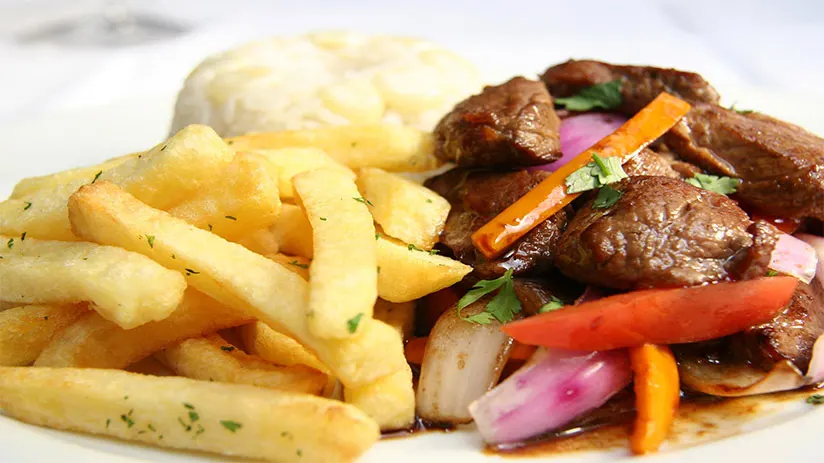
There is nothing more Peruvian than the delicious Lomo Saltado. If you want to taste one of the most delicious and essential fusion food dishes in your Peru trip, the Lomo Saltado is your best option. The history of this dish goes back to the time when Chinese cuisine began to have a great influence on our country. Therefore, we can say that the Lomo Saltado is the best example of an international (Chinese) and a national (Peruvian) cuisine fusion, the Chifa.
This representative dish consists of sliced steak, red onions, tomatoes, French fries, and yellow pepper, all sautéed over a skillet with a base of oil, soybean sauce (Sillao), and finely chopped garlic. The secret technique is the saute all these ingredients. Some cooks even let the fire of a kitchen burner invade the skillet, all a spectacle for someone who can view its preparation. White rice, even some restaurants include a fried egg in the accompaniment of this dish. Amazing!
Where to eat Lomo Saltado?
Dommo Saltado restaurant. Address: Ignacio Merino 2501 Avenue. Lince, Lima.
15. Arroz Chaufa (Chaufa Rice)
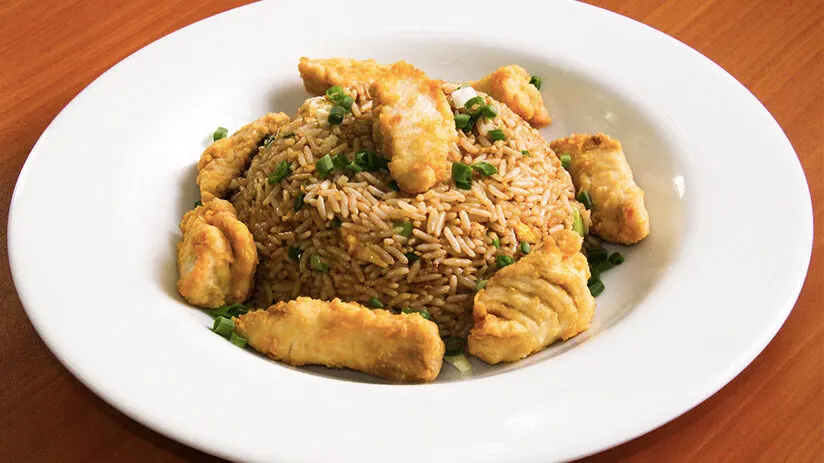
The high influx of Chinese migration that Peru received since 1849 brought with it not only people but also its culture and its own Chinese ingredients. As the Chinese were the migrant majority for many years, the import of Chinese ingredients to Peru increased and was mixed and expanded in local Peruvian markets. It is in this way that today Peruvian and Chinese cuisine share similar flavors, colors, and spices. Resulting in the famous Chifa food.
The classic accompaniment for all Chifa dishes is the Arroz Chaufa, and it is the main Plato of all Chinese-Peruvian restaurants around the country. History tells us that Chinese cooks used to reuse leftover ingredients from the previous day’s restaurant menu to prepare their lunch (In a way to save on food costs for restaurant staff). In this sense, the cooks chop and saute with rice some vegetables like Chinese onion (scallions) and ginger. Soybean sauce, oyster sauce, and sesame oil seasoned the mix inside a bowl. Similar to Lomo Saltado’s preparation, the secret of cooking was the form of sauteing. Separately, a beaten egg was fried, along with pieces of chicken and/or meat, and chopped into cubes. In some parts of the Andes, the quinoa substitute the rice. Undoubtedly, this dish is proof of a harmonious combination of two cuisines, separated by culture, but united by Peru’s geography.
Where to eat Arroz Chaufa?
Madam Tusam restaurant. Address: Santa Cruz 859 Avenue, Miraflores, Lima.
16. Pollo a la Brasa (Roasted Chicken)
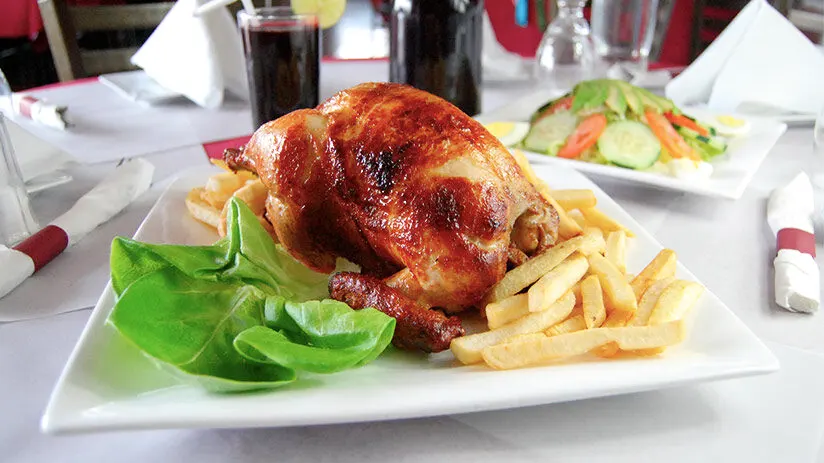
What do the US and Peru have in common? Well, Pollo a la Brasa is the most consumed dish in both. This is undoubtedly one of the most famous traditional dishes of Peruvian gastronomy. The key is to marinate the chicken in a special sauce. This soy sauce features red bell peppers, garlic, and cumin that give the chicken a smoky, delicious flavor. The Peruvian cooks typically cook these marinated chickens over hot coals and serve them whole.
They are accompanied by French fries and fresh or cooked salads. In addition, the commensals usually eat it with well-known sauces and other spicy ingredients. All the countries use this Peruvian recipe.
History tells us that a Swiss called Roger Schuler arrived in Peru in 1940, and he began to raise chickens and sold them to subsist and find a better economic future. One fine day, he decided to put an extra value to his product and roasted a chicken over coals, fried some chopped potatoes, and was done! He had a new dish, the Pollo a la Brasa. Nowadays, its restaurant “La Granja Azul” still attends to Peruvian customers with the original recipe of Pollo a la Brasa.
Where to eat Pollo a la Brasa?
La Granja Azul Polleria. Address: Carretera Central, 11.5 Km. Ate Vitarte, Lima.
17. Anticuchos (Grilled beef heart)
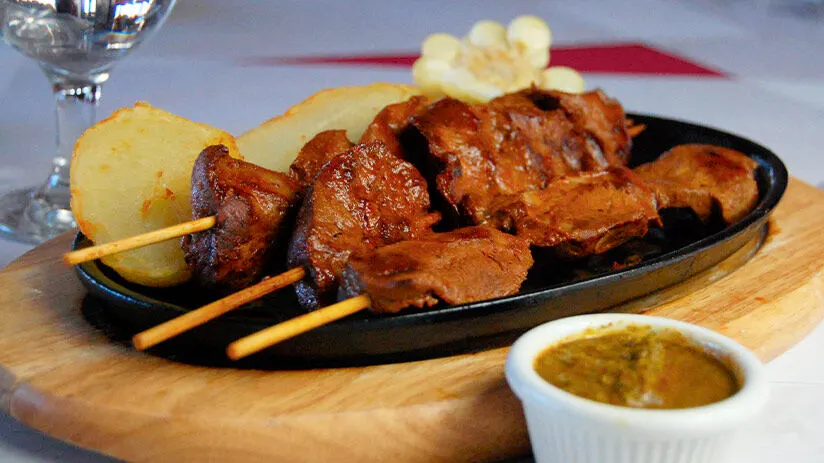
The Anticucho is one of the most representative Peruvian street foods that you have to try during your visit. This delicious typical food of Peru had its origin in the regions of the Andes during the colonial times (16th century) when the Spanish conquerors took advantage of the best pieces of beef for their consumption and leave leftovers for their servitude. Years later, the form of preparation of the heart, kidney, and intestines of the beef passed to the Peruvian coast region where the recipe found its final style.
It has been a traditional food of Peru for a long time. The hearts cut into cubes are its main ingredient. The cooks marinated these in vinegar, cumin, chili, and garlic and then put them on sticks to be roasted on charcoal grills. After, they serve Anticuchos on skewers with potato or onion slices, over a dish. A total delicatessen. They are a real appetizer to try in the afternoon.
Today, many Chefs have reinvented this dish and used other cuts of meat in addition to the heart. You can see chicken Anticuchos and other meat cuts, but the real Anticucho have heart meat.
Where to eat Anticuchos?
Marabunta restaurant. Address: Av. Horacio Urteaga 1526. Jesus María, Lima.
18. Trucha Frita (Fried Trout)
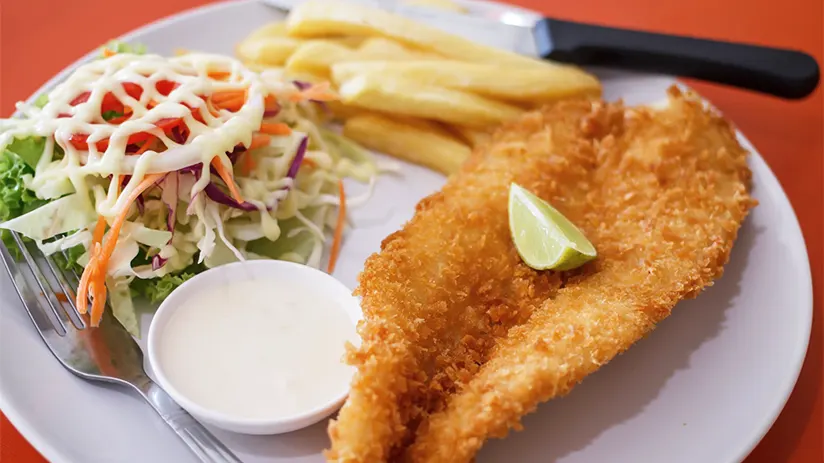
Fried trout is a traditional dish typical of the Andes of Peru. The Andes Mountains provide different bodies of freshwater where trout can easily breed. And in many Andean regions, it is common to see trout farms. Even, Peru is one of the largest exporters of rainbow trout. Also, the specialist considers the trout of Peru as the best in the world. So, this trout is fried and seasoned with black pepper, served with white rice, potato fried, and vegetable salad. So, we recommend you try this dish without exception.
Where to eat Trucha Frita?
Señor Limón restaurant. Address: Guillermo Prescot 370 Avenue, San Isidro, Lima.
19. Chicharron (Fried Pork Rind)
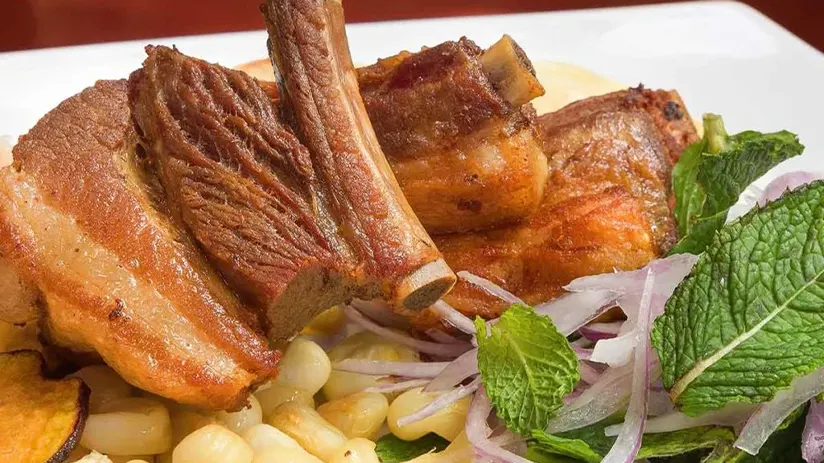
Chicharron is nothing more than fried pork belly. It is one of those unhealthy but classic dishes among Peruvians. It is served with fried potatoes, parboiled corn kernels, and a salad made with fresh onion and peppermint. Its preparation is simple, you have to put the pork pieces in water with salt, and celery, and leave them marinated for a few hours. After that, the cooks boil the pieces of pork. Finally, the cook fries the meat, soft and tender, in its own grease, and well done! This delight is ready to be the pleasure of everyone!
Where to eat Chicharron?
Chicharrones del Inca restaurant. Address: Caminos del Inca 1902, Surco, Lima.
20. Pachamanca (Steamed food underground)
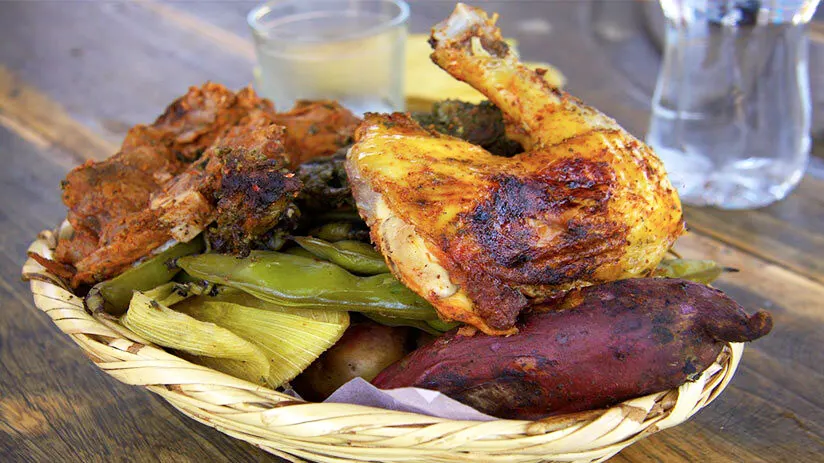
In the rural Andean areas of Peru, there is an ancient tradition that locals still practice. The tradition says that the dish and its preparation is a tribute to earth (Pacha means earth and Manca means pot or oven in the Quechua language). Which gave the Peruvian Andean people the vegetables and food necessary to exist. Therefore, Peruvians prepare Pachamanca on special occasions and at harvest time.
The Pachamanca is one of the traditional dishes that Peruvians prepare in the heat of preheated stones. The cooks previously season vegetables, potatoes, sweet potatoes, beef, pork, chicken, and guinea pigs to give them a unique flavor. After, these are put inside a hole dug in the ground. Stones (previously heated with firewood) go in the hole bottom, the other ingredients follow, and the preparation has to be well wrapped by leaves. Finally, the dust covers all the preparation. Finally, you can cook the preparation for 3 to 4 hours, and well done! You will have the best representation of biodiversity in Peru (by its ingredients), the Pachamanca.
Where to eat Pachamanca?
Hotel Turistico El Tinajón restaurant. Address: San Martin 2410 Avenue, San Martin, Lima.
21. Papa a la Huancaina (Potatoes in Spicy Cheese Sauce)
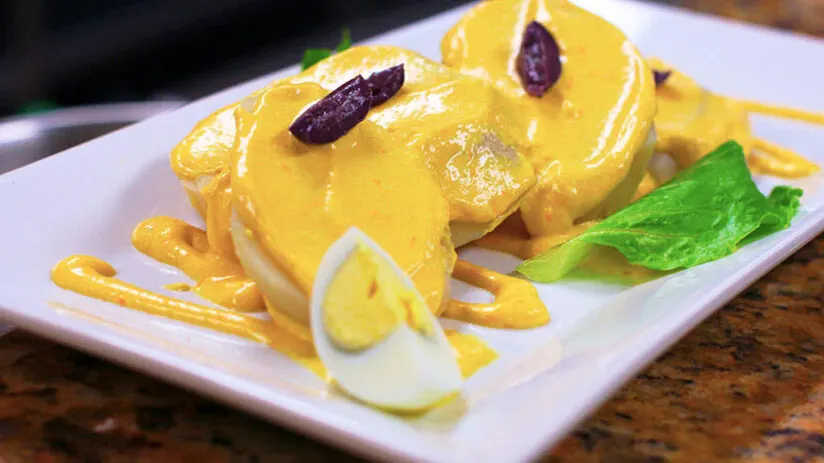
Papa a la Huancaina is one of those popular appetizers among the people of Peru. This dish consists of boiled yellow potatoes (Among 3000 potato varieties that Peru has) served with a spicy, creamy yellow sauce made from cheese, milk, and yellow peppers, previously blended. The history is not clear, but the dish has its origin in Huancayo, a central city of Peru, close to the Andes Peruvian food. In addition, Huancaina is the name of the yellow sauce, hence the name Papa a la Huancaina. It is one of the few traditional dishes of Peru that could be considered vegetarian, and it’s a tribute to the Peruvian potato and the yellow pepper.
Where to eat Papa a la Huancaina?
Mi Propiedad Privada restaurant. Address: Costanera Avenue 1010, San Miguel, Lima.
22. Juane (Rice with chicken wrapped in banana leaves)
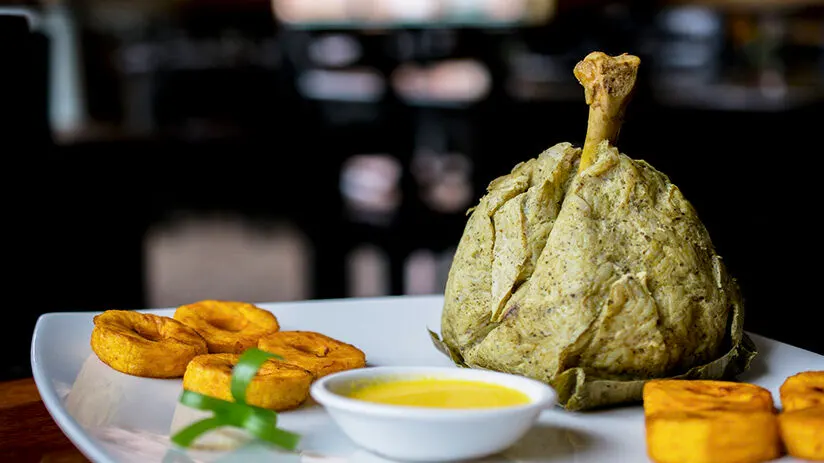
Juane is one of the most representative dishes in the Amazon of Peru. The dish is prepared on special occasions and in the San Juan Bautista (Saint John Baptist) festivity on June 24th every year. This festivity gives its name to the dish, Juan, Juane. The presentation of this dish is exotic but its flavor will not disappoint you. We can assure it. The preparation consists of white rice seasoned with local spices that can accept oregano, turmeric, boiled egg, and cumin. A piece of chicken goes in the middle of this preparation. All this is wrapped between Bijao leaves and put on boil inside a big casserole. The cook lasts 1 hour, and it is usually to be served with yucca and banana, both boiled too.
Where to eat Juane?
El Pichito restaurant. Address: General Vidal 803 Jirón, Breña, Lima.
24. Tacacho (Baked banana dough)
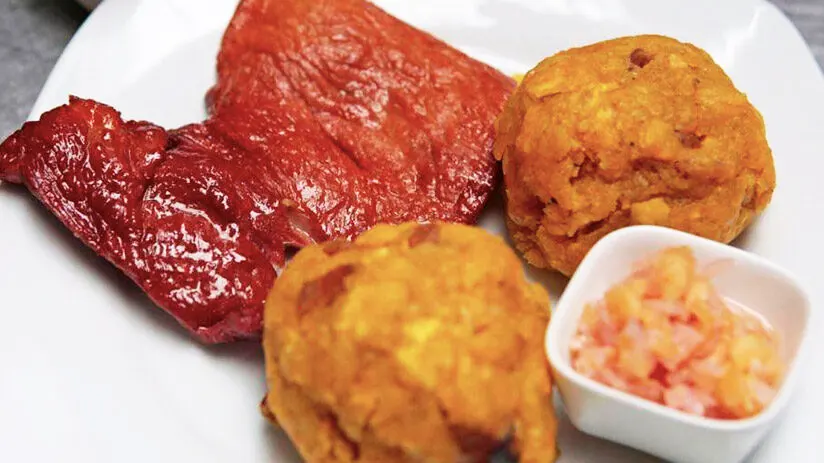
Tacacho is another representative dish of the Amazon. Its origin is situated in the north of the Amazon region of Peru, where local tribes boil bananas. After that, they ground the cooked fruit in large stone mortars, obtaining a mass. This one is combined with pork pieces and butter, salt, and cumin. The cooks give the mass the form of small balls that are served with chorizo and jerky (Beef salt meat). Usually, this dish is consumed for breakfast, and its flavor is unique. Even, some locals consume it, such as one of their favorite Peruvian desserts.
Where to eat Tacacho?
El Aguajal Amazonian traditional restaurant. Address: Jr. Huiracocha 1498 Jesús María, Lima
24. Cuy Chactado (Fried guinea pig)
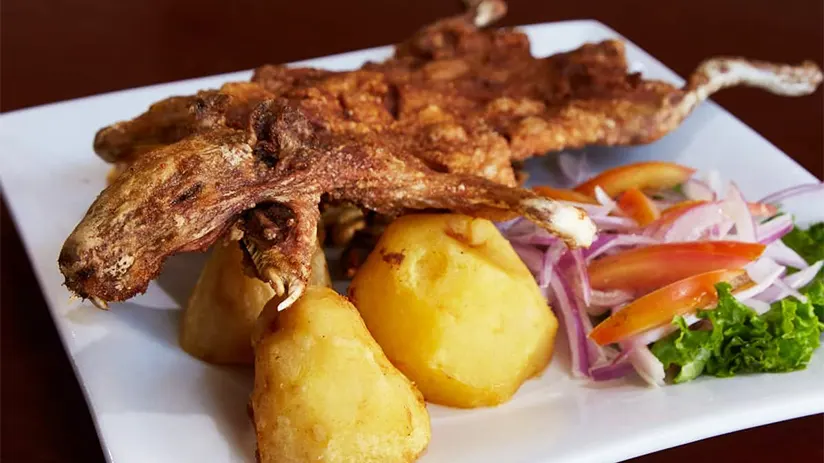
The delicious Cuy is a very traditional dish in the mountains of Peru. If you have a pet guinea pig, you may not like this suggestion. But many Peruvian farm families, which live on Mountain Range slopes, usually raise these animals and, on special occasions, the locals of Peru eat them. The Cuy is a guinea pig that is baked in a wooden oven. Although it can also be served fried or roasted with potatoes, accompanied by noodles and stuffed peppers. Also, Cuy has healthy proteins and fats for humans. So, don’t let tenderness win you over, and dare to prove this exotic dish!
Where to eat Cuy Chactado?
Pachapapa Restaurant. Address: Carmen Bajo 120. San Blas neighborhood, Cusco.
25. Rocoto Relleno (Stuffed Spicy Peppers)
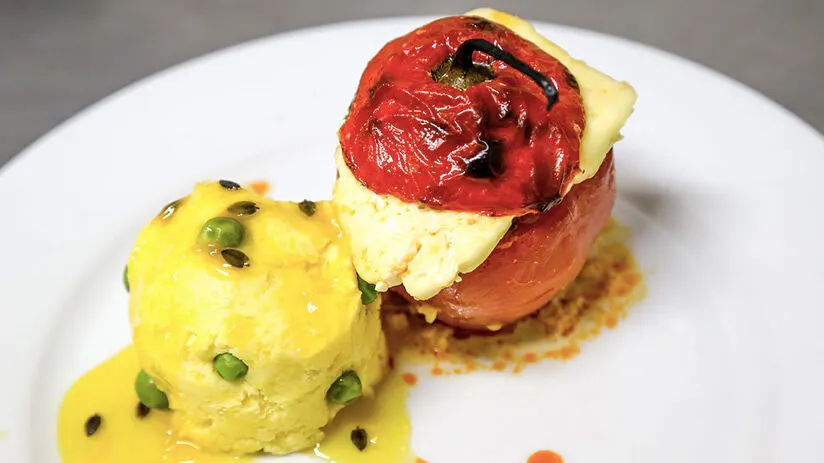
The Rocoto Relleno is another great traditional dish that you cannot miss. These consist of roasted bell peppers that are stuffed with chopped meat and vegetables. They are baked with a delicious dough of milk and eggs that covers the pepper. One of the most delicious traditional dishes in Peru. Be careful with its intense flavor, the Peruvian peppers are 10 times spicier than a Jalapeño (pepper native of Mexico). Therefore, the first bite will be valuable proof for you. Passing this challenge, your enjoyment will not have a limit.
Where to eat Rocoto Relleno?
La Nueva Palomino Picanteria. Address: Leoncio Prado Street 122, Yanahuara, Arequipa.
26. Adobo (Spicy pork stew)
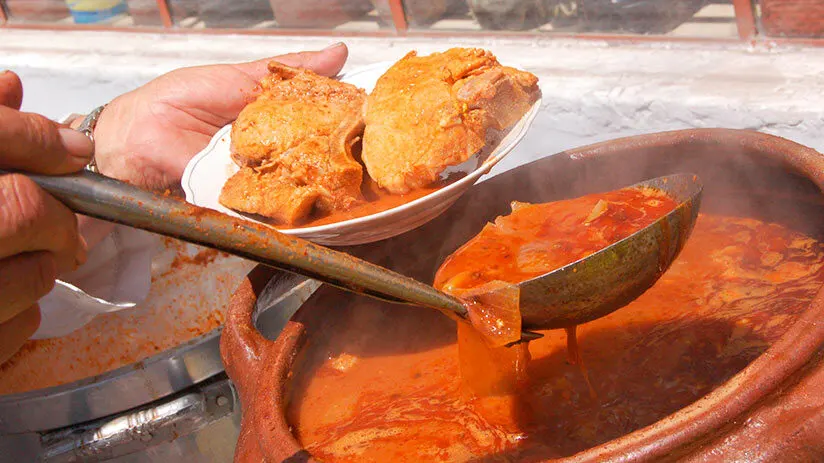
Adobo is one of Arequipa’s favorite traditional dishes. Many people usually eat this regional Peruvian food for breakfast, on Sundays. Spicy pork stew could be the other name for Adobo. It often consists of pork in a delicious sauce flavored with Ají Panca, Chicha de Jora, and other spices. Many countries like the Philippines, Mexico, and Puerto Rico also have dishes with the name Adobo. However, the ingredients and meat used in the marinade vary from country to country. By the way, if you did not know, the difference between Mexican and Peruvian food is the origin of the main ingredients that make up each dish of their gastronomy. While Mexican food is based on corn, the Peruvian one is based on fish and marine animals. In everything else, these cuisines are similar since they are varied, colorful, spicy, and very delicious.
Where to eat Adobo?
La Lucila picanteria. Address: San Miguel Street 147, Sachaca, Arequipa.
27. Chupe de Camarones (Shrimp Chowder)
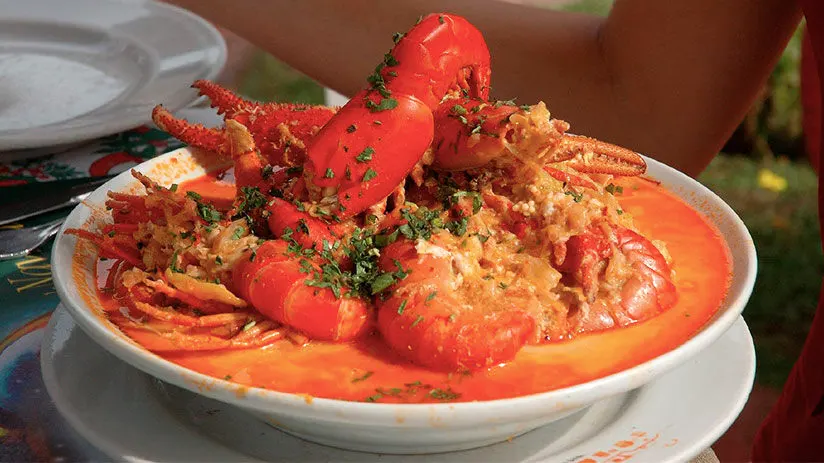
Chupe de Camarones is the most representative soup of Arequipa cuisine. This dish comes from the Camana coast district and, nowadays, Peruvians enjoy it only for special occasions, birthdays, and festivities around of Peru. The Shrimps are the kings here and its preparation consists of Shrimps (obviously), cream of milk, and cheese, with a base of fish broth, red onions, eggs, garlic, and yellow potatoes. This soup has to boil for a few minutes. After that, white rice, beans, carrots, and peas are included. A cook of 45 minutes more and well done! You have a succulent Chupe de Camarones. Even, many consider that this dish is equal in flavor to Peru national dish, Ceviche.
Where to eat Chupe de Camarones?
La Trattoria del Monasterio restaurant. Address: Santa Catalina Street 309, Historic Center of Arequipa.
28. Capchi de Setas (Mushroom stew)
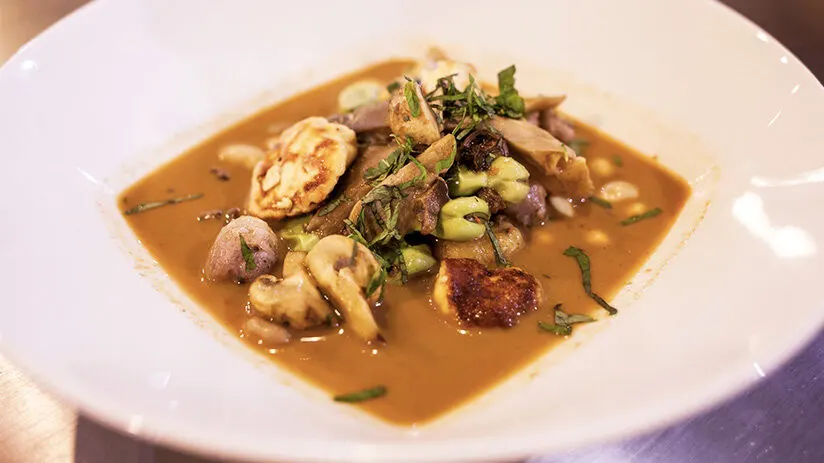
If Arequipa (The other big Peruvian south city) has the Chupe de Camarones, Cusco has the Caphi de Setas. This dish is a kind of thick soup made up of potatoes, green beans, eggs, milk, fresh cheese, mint, huacatay, paico, and Setas (fungi that grow only in rainy seasons). Specifically, in places where lightning struck). All of them are boiled for around 40 minutes. The result is a hearty soup. The locals eat it, only, in the rainy season (from December to March) and on special occasions like local festivities. Usually, white rice and Cuy accompany this dish. A real delight of the Inca’s capital.
Where to eat Capchi de Setas?
(In special occasions) Pachapapa Restaurant. Address: Carmen Bajo 120. San Blas neighborhood, Cusco.
29. Chiriuchu (Dried meat chunks)
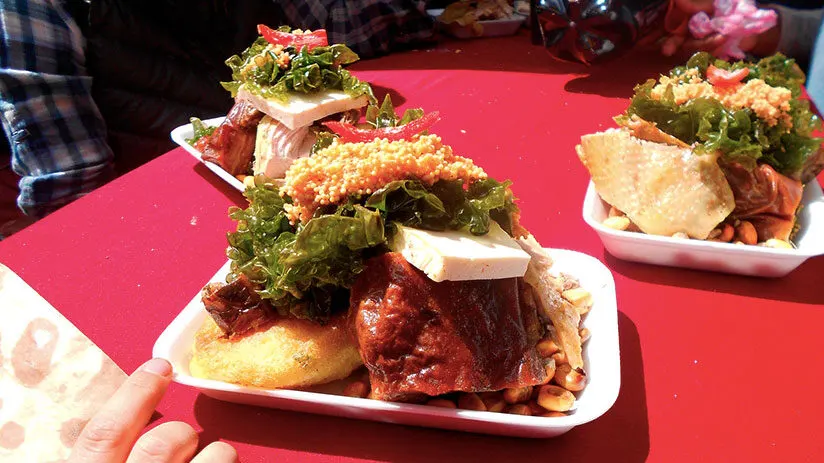
Maybe, the Chiriuchu is the most known Cusco dish around the country. This dish contains ingredients from three natural regions; coast, mountains, and jungle. Its Quechua name means “Cold spicy”. History says that after the Ayni (An Inca system in which every member of town or community participated in the construction of some public buildings like bridges, Tambos, inter alia) they shared the best food each one had in their houses.
In this form, a dish with a variety of ingredients and products from all Peruvian regions was born. In this form, Ingredients like seaweed, egg cup, hen, charqui, and black pudding are boiled. Other ingredients like a guinea pig, potatoes, and corn fritter are fried separately. The last step is to put all the ingredients together in a dish and adorn it with cheese, toasted corn, and hot pepper. It is served cold. A Peruvian variety in one dish.
Where to eat Chiriuchu?
Usually, the Cusco people enjoy the Chiriuchu in all the restaurants, during the traditional Cusco festivity named Corpus Christi every June 16th. This is a religious holiday in which giant sculptures of 12 saints are taken out and paraded around the entire main square by porters.
30. Guiso de Tarwi (Tarwi Stew)
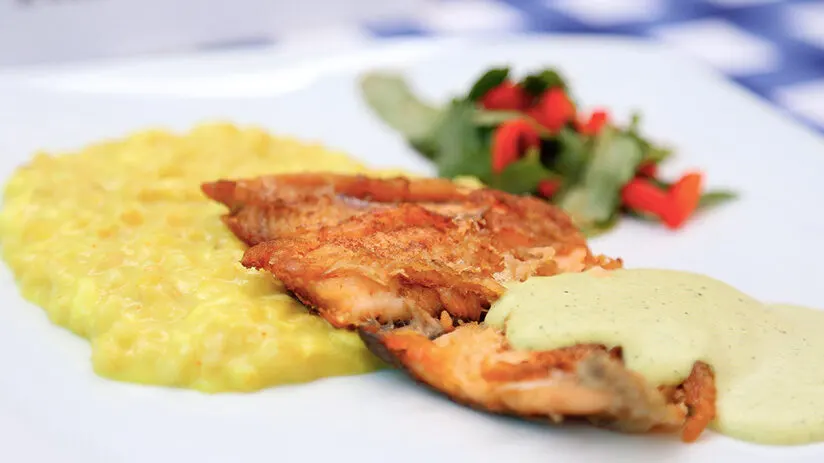
Tarwi is an Andean legume cultivated in Peruvian Andean cities like Cusco, Cajamarca, Huanuco, Junin, and Puno. It is considered one of the Peruvian superfoods of its energy contribution. Between 2000 and 3800 meters above sea level. Its origin dates back to pre-Inca times when cultures like Nazca and Tiahuanaco cultivated it. Cusco, as the origin place of this legume, prepares the Tarwi and blends it with cheese and milk. The mix is seasoned with butter, cumin, and ground garlic. This dish usually is served with white rice or it can accompany a plate of stew.
Where to eat Guiso de Tarwi?
Unfortunately, this is a just homemade dish and not very common to find in local restaurants, even Picanterias. However, if you have luck, during your take walk through the traditional market of San Pedro, you can find it included in the menu of food stands located there.
“ONE CAN NOT THINK WELL, LOVE WELL, SLEEP WELL IF ONE HAS NOT DINED WELL”
Do not miss these delicious dishes that give so much to talk about in the world. As you can see, Peru has a lot to offer in terms of traditional Peruvian food. Tour the Andean country and its many traditional delicacies. We hope together with Machu Travel Peru has been helpful. If you want to know more about our tours or the great variety of dishes that the country has, you can consult with our advisors.
